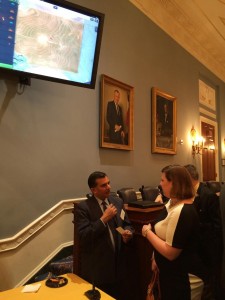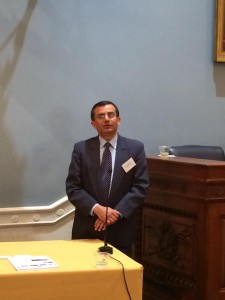Contributions to this post were made by Shashi Shekhar, Computing Community Consortium (CCC) Council member and Distinguished University Professor at the University of Minnesota.
The Task Force on American Innovation held a Capitol Hill reception titled “Deconstructing Precision Agriculture” on Wednesday. The Computing Research Association was a co-sponsor of the event. It showcased U.S. farmers, leading agriculture technology companies, and scientists including Computing Community Consortium (CCC) Council member and University of Minnesota distinguished university professor Shashi Shekhar.
The event exhibited three essential technologies of precision agriculture that originated from a broad spectrum of federally funded science: Guidance Systems and GPS, Data & Mapping with GIS, and Sensors & Robotics.
Rajiv Khosla, Professor of Precision Agriculture at Colorado State University opened the reception by saying that “precision agriculture is not rocket science, but we use rocket science to do precision agriculture.”
Shashi Shekhar explained that the geographic information system (GIS) based soil maps help farmers see that soil properties and fertilizer needs vary across locations in a large farm. GIS and complementary spatial computing technologies help farmers apply the right amount of fertilizer at each location within a large farm to increase yield while reducing waste and runoffs. If you apply the same amount of fertilizer everywhere you are over fertilizing in some places (which leads to increased runoff) and under fertilizing in others (which reduces yield). To relate the need for this technology, William R. Raun, Professor at Oklahoma State University pointed out, you don’t go to a gas station and put fifteen gallons of gas in a ten gallon tank, watching five gallons spill. GIS soil maps help tractor-based spatial decision support systems control for this and prevent excess runoff and conserve water, while increasing yield by location-aware rate of fertilization. Farmer Del Unger of Carlisle, Indiana, said that precision agriculture has dramatically increased yields and farm profitability. Farmer Rod Weimer, of Fagerberg Produce in Eaton, Colorado said it himself when he remarked that “Technologies like this makes farming more fun.”
Shekhar added that agriculture is not only a compelling use case of but also the inspiration for many transformative spatial computing discoveries and inventions. Positioning methods, e. g, modern GPS, started with land surveying by Egyptian civilization to reestablish farm ownership boundaries periodic erased by Nile floods. Spatial statistics traces its roots to concern of agriculture census that agricultural samples violated central assumptions underlying sampling theory. Many new basic research challenges and opportunities including many in Computer Science, are arising from the societal need of dramatically increasing farm yields without degrading environment to address food security (as well as the nexus of food, energy and water security) in face of growing population, increasing urbanization in developing world, and climate change.
This topic is of great interest right now. The National Science Foundation (NSF) released a Dear Colleague Letter (DCL) called SEES: Interactions of Food Systems with Water and Energy Systems that encompasses precision agriculture and more.
NSF established the Science, Engineering, and Education for Sustainability (SEES) investment area in 2010 to lay the research foundation for decision capabilities and technologies aimed at mitigating and adapting to environmental changes that threaten sustainability.
In this context, the importance of understanding the interconnected and interdependent systems involving food, energy, and water (FEW) has emerged. Through this Dear Colleague Letter (DCL), the NSF aims to accelerate fundamental understanding and stimulate basic research on systems that extend beyond the interests of the SEES Water Sustainability and Climate (WSC) program to include couplings to energy and food systems where the NSF already has established presence.
The NSF requests innovative proposals for (1) supplements, to build upon existing NSF-funded research activities; or (2) workshops of typically 30-80 attendees that stimulate debate, discussion, visioning and collaboration across research communities, and enable a higher appreciation, visualization and understanding of food systems and their couplings to energy and water systems.
This is a huge opportunity with tremendous impact potential for the computer science community. These workshops are to prepare for the transition to the Innovations at the Nexus of Food, Energy and Water Systems (INFEWS) Program under NSF’s new FY 16 budget request. If you are interested, workshop proposals and supplement requests must be submitted by March 30, 2015 for consideration. For more information, please see the DCL.











